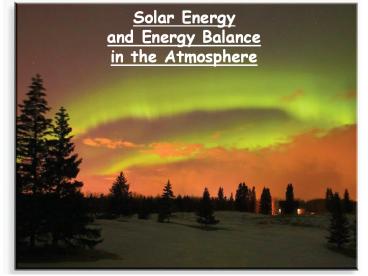Solar%20Energy%20and%20Energy%20Balance%20in%20the%20Atmosphere - PowerPoint PPT Presentation
Title:
Solar%20Energy%20and%20Energy%20Balance%20in%20the%20Atmosphere
Description:
Solar Energy and Energy Balance in the Atmosphere – PowerPoint PPT presentation
Number of Views:172
Avg rating:3.0/5.0
Title: Solar%20Energy%20and%20Energy%20Balance%20in%20the%20Atmosphere
1
Solar Energy and Energy Balancein the Atmosphere
2
Mid-chapter summary
- The temperature of a substance is a measure of
the average kinetic energy (average speed) of its
atoms and molecules. - Evaporation (the transformation of liquid into
vapor) is a cooling process that can cool the
air, whereas condensation (the transformation of
vapor into liquid) is a warming process that can
warm the air. - Heat is (thermal) energy in the process of being
transferred from one object to another because of
the temperature difference between them. - In conduction, which is the transfer of heat by
molecule-to-molecule contact, heat always flows
from warmer to colder regions. - Air is poor conductor of heat.
- Convection is an important mechanism of heat
transfer, as it represents the vertical movement
of warmer air upward and cooler air downward. - All objects with a temperature above absolute
zero emit radiation. - The higher an objects temperature, the greater
the amount of radiation, and the shorter the
wavelength of maximum emission.
3
Methods for heat transfer in the atmosphere
- Thermal conduction
- It requires physical contact, temperature
difference - The energy flow is from a body with high T to a
body with low T. - It is important only for a thin layer close to
the ground. - Convection (advection)
- Winds in the atmosphere can transport energy.
- Very efficient way of energy transport in the
atmosphere. - Radiation
- All bodies with Tgt 0 K emit EM waves.
- EM waves can propagate in vacuum.
- The EM spectrum of a body is the energy it emits
at different wavelengths - The higher the temperature the more energy is
emitted (SB Law) - The wavelength at which the peak of the EM
emission of a body occurs is determined by its
temperature (Wiens Law).
4
Radiation and Temperature
- All bodies with Tgt0K emit radiation
(electromagnetic energy). - The origin of the emission is the transition of
the atoms (molecules) from one energy state to
another. - The wavelength and the amount of energy emitted
by the body depend on its temperature. - Higher T -gt larger internal energy -gt atoms
vibrate faster -gt the radiation has shorter
wavelength and higher energy.
The Suns electromagnetic spectrum
5
Temperature and Emitted Energy
Energy
The Sun emits (6000/288)4188,000 times more
energy than the Earth!!!
6
Sun/Earth radiation
- Sun
- T6000 K
- lmax0.5 mm
- Maximum in visible
- Earth
- T288 K 15 C
- lmax10 mm
- Maximum in IR
The Sun emits (6000/288)4188,000 times more
energy than the Earth!!!
7
Radiative Equilibrium
gt
Emission
Absorption
Cooling
lt
Emission
Heating
Absorption
Emission
Absorption
Equilibrium Tconstant
8
The Earths Balancing Act Absorption, Emission
and Equilibrium
- First, suppose the Earth had no atmosphere at all
- Energy from the Sun would be absorbed during
daytime - Energy would be radiated away 24/7
- Average surface temperature at equilibrium
255K-18C0F - Why arent we freezing to death?
9
The greenhouse effect of the atmosphere
With Atmosphere
No Atmosphere
T255 K
T288 K
10
Selective Absorbers/Emitters
- Trees absorb visible energy from Sun, radiate in
infrared - Snow away from trees reflects visible sunlight,
stays cold - Snow near trees reflects visible sunlight, but
absorbs the infrared radiation from nearby trees,
heats up and melts.
11
Atmospheric Greenhouse effect
- The gases in the Earths atmosphere are selective
absorbers - Greenhouse gases absorb the infrared radiation
from Earth - Also selectively radiate in the infrared, a
fraction goes back to Earth - The Earths greenhouse effect H2O 60 CO2 26
rest 14
H2O, CO2
O2, O3
H2O, CO2
O3
12
Fig. 2-11b, p. 41
13
Fig. 2-11a, p. 41
14
Fig. 2-11c, p. 41
15
The greenhouse effect of the atmosphere
With Atmosphere
No Atmosphere
T255 K
T288 K
16
The lower atmosphere is heated from below!!!
17
The Incoming Solar Radiation
- Insolation Incoming Solar Radiation
- The solar constant the energy from the sun at
the TOP of the atmosphere per unit surface per
unit time (1367 W/m2) - Scattered light scattering from molecules, dust
particles, aerosols. - The scattered (diffuse) light goes in all
directions. - Shorter wavelengths are scattered more
efficiently by the atmosphere (the sky is blue,
see Chapter 19). - Reflected light some light is sent backwards.
- Albedo the percentage of the incident light that
is reflected. - The albedo is a measure of the reflectivity of
the surface - Absorption
18
Table 2-3, p. 44
19
The solar energy budget
20
The Energy Balance
- The amount of incoming energy should be exactly
equal to the amount of the outgoing energy!!! - The Earth
- IN Solar radiationCloud IR emission
- OUT ConductionConvectionH2O Evaporation IR
emissionReflection of solar light - The atmosphere
- IN from the ground (convection,conduction,latent
heat,IR emission)solar radiation - OUT to the ground (IR emissionreflected
light)to space(IR radiation) - The Earth atmosphere
- IN Solar Radiation
- OUT IR radiation (groundatmosphere)Reflected
light
21
The Earth Energy Balance































